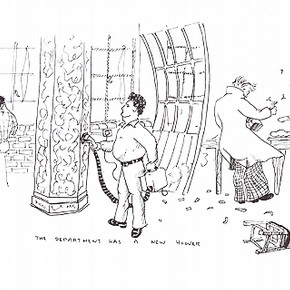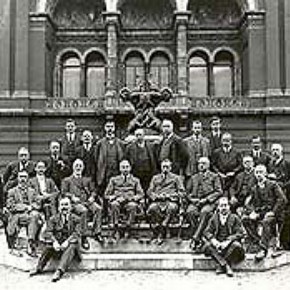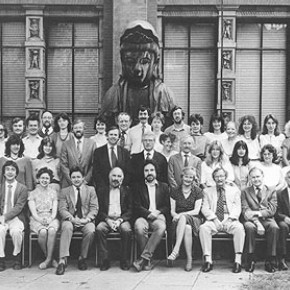Conservation Journal
Summer 2005 Issue 50
Rising damp - a history of the Conservation Department
The work alternated between packing, mounting, framing, cleaning and repairing. Every medium and every type of work was attempted: cleaning tapestries, covering chairs, repairing labels, repairing metal tankards, even repairing stained glass windows. Activities did not always take place in the workshop, but throughout the building and off site. Work such as 'taking down tapestry in the Raphael Gallery, framing paintings in the North Court', 'mounting miniatures in Reception', 'framing and mounting needlework in the North Court from 8am to 8pm'.1 In some catalogue entries it made occasional reference to alterations performed by the 'Art Workshop' but with very little reference to the materials and techniques used.
The transition from Art Workshop 'repairers' to Conservation did not happen until after the Second World War. 'Change was an inevitable part of the explosive growth and development of conservation throughout the world spurred on by need; generated by headline catchers such as the "Florence floods" and "Venice in Peril"'.2 This transformation, which began in 1960, was lead by Norman Brommelle3 and then after his retirement in 1977, by Dr Jonathan Ashley-Smith,4 the second Keeper of Conservation. Both keepers pressed for the expansion of the Department and a major increase in space and staff took place around 1977.
Throughout its history, the Conservation Department has been changing, developing, progressing, expanding and contracting. Specialist areas like miniatures, gilding, framing, tapestries and book conservation have flourished independently and then have been absorbed into larger groups. As sections grew they populated any available pockets of space at South Kensington. The sections were scattered widely across the site making it difficult to manage and this also hampered communication.
It seems appropriate that the 50th edition of the Conservation Journal is used to reflect on the Department and the Journal's beginning and how the Journal has helped to document the changes in the Department, developments in the profession, fashions, trends and working practice inside and outside the Museum.
The origin of the Journal came about at the first ever meeting of the whole Conservation Department in 1978. The main topic of that meeting was communication. At this time the Department consisted of nine specialist sections working in fifteen locations and with no central meeting point. It was thought that Conservation would benefit from exchange of ideas and a greater sense of Departmental identity. The first Newsletters, made up of several typed sheets (the first electronic typewriter was purchased in 1983), were photocopied and stapled together. These reported on recent conservation work, purchases of equipment and visits to other workshops.
As the Newsletter developed, articles got longer and more informative and were punctuated throughout with cartoons. There were cynical and witty articles, conservation crosswords and reports on happy events. The Spring 1984 Newsletter was attacked for not being serious enough and it had been given over to a bunch of 'scurrilous cartoonists and flippant pretentious literati'.5 There was dissatisfaction from staff who did not want to publish serious work in an in-house magazine, but it was no longer an in-house magazine, the distribution had increased and it had found its way to Rome and been accepted into the IICROM Library.6
By 1985 came the first refurbishment and reorganisation of the Conservation Department costing one million pounds. The newly refurbished Conservation Library served as focal point or meeting place for the Department. The Newsletter gave way to the Conservation Bulletin with news in brief and calendars of forth coming events.At the first Conservation Residential it was agreed there was still room for improvement if it was to reach a wider audience. So the V&A Journal in its present style was one of the outcomes of the meeting. The Department had been accused of insularity and there was a need to build bridges and improve communication with curatorial departments and senior managers in the Museum and to colleagues and professionals outside the Museum.
The first issue of the V&A Conservation Journal was published in October 1991. It was designed by Richard Doust at the RCA7 and one of the driving forces behind the change in appearance and content of the Journal at the time was the development of the RCA/V&A Conservation course in October 1989. The Journal was a means by which students could publish ongoing research, and it was also a publication which was intended to give a quarterly snapshot of the work of the Conservation Department at the V&A, written by interns, staff, contractors and guest writers.
Issue 20, 1996 records another landmark in the Conservation Department at the V&A. In 1992 Austin Smith: Lord were commissioned to prepare designs for the conversion of the Royal College of Art building. The aim of the project was to bring together all the Museum's Conservation sections that were scattered around the South Kensington site and Osterley Park.
In December 1995 Conservation Administration, Paper, Books, Textiles, Sculpture and Science Conservation moved to the RCA block. The large flexible spaces enabled projects that could not have been entertained prior to the move to be undertaken. The amount of practical work increased with greater efficiency. The new facilities have provided space to train students, interns and placements drawn from institutions here and abroad. Numerous courses have taken place to provide on-going training for conservators from all over the world. In 2004, Administration moved and Paintings have since joined Books Conservation.
Issue 34 marks the beginning of a New Year and a new century 'Out with the old in with the new'. The theme for this issue is 'contemporary', reminding us that the V&A was founded as a contemporary museum. The wish to strengthen the relationship with the audience under pins the current contemporary initiative. This also presented the Conservation Department and the Museum with new ways of working in presenting/preparing objects for display, investigating forms of display which allow design to be experienced as well as looked at. By the time this is published the next major contemporary show entitled 'Touch me' will be open, where the audience is invited to touch, stroke and interact with objects on display. Issue 39, Autumn 2002, of the V&A Conservation Journal celebrates the completion of the British Galleries. It highlights the immense range of work and scientific activity undertaken in the Department over five years prior to its opening in November 2001. It also discusses the development of the CONCISE data-base and a new way of working for the Department.

Figure 3: 'The Department has a new hoover', from the V&A Conservation Archive (click image for larger version)
The British Galleries was the biggest project the V&A had embarked upon for fifty years and the largest project the Conservation Department had ever undertaken. Over the next four years and beyond, the Museum will need a continued high level of delivery from the Conservation Department for projects within the FuturePlan. CONCISE is being used as management tool for projects such as the Architecture Gallery, Medieval & Renaissance Galleries, the Sculpture Techniques Gallery and Exhibitions. It is being developed so that all work carried out in the Conservation Department will be recorded on CONCISE.
The theme of Journal 41, Summer 2002, is 'out reach'. The contributions in this Journal describe different ways the Department communicates and interacts outside the Museum. The Sharing Museum Skills programme funded by the Millennium Commission, funded two secondments to spend time in the Conservation Department. Collaborative Projects such as the Japanese Lacquer Project with Japan, which has recently received funding from the Getty Foundation, work and advise on projects abroad such as the Satyajit Ray Archive in Calcutta and the partnership project with the Prince of Wales Museum of Western India - described in this issue .
It would be impossible to write this article without including the greatest influence on the Department over the last 25 years. In his last editorial Jonathan Ashley-Smith introduces issue 41: 'Reaching out'. After 25 years, Jonathan Ashley-Smith, gave up his post as Head of Conservation to become a senior member of the Research Department of the V&A. He did this in order to write his second book for Elsevier Science 'Sustainability and Precaution in the Conservation of Cultural Heritage' to be published in 2005. He continues to teach on the RCA/V&A course, in Europe and beyond and continues to communicate conservation to the widest possible audience.
Since Jonathan's departure there have been many changes to the Museum and the Department and these events have been published in subsequent issues of the Conservation Journal. Issue 44 is introduced by Sandra Smith, the new Head of Conservation, who started at the V&A in January 2003. In Journal 46 the New Paintings Gallery is reported on and OCEAN8 is also in place and reported to be working well. The Department once again changes its shape to align itself with the changing Museum and the structural chart on the back of the Journal was redesigned to reflect these changes and identify the new senior management team. This reorganisation was carried out in November 2003.
It is interesting to return to the content of the earlier publications documenting the Department and make comparison with the more recent ones in terms of the changing attitudes to conservation, the changes within the Department, how the needs of the Museum are reflected in the articles and how the position/status of the Department has evolved.
The Journal continues to be a cost affective way of reaching thousands of people and a useful tool to chart the developments in the Department. To signal another land mark in the history of the Department and the V&A and under the direction of Sandra Smith, the Conservation Journal is now available on the Web.
Acknowledgements
Thanks to Jonathan Ashley-Smith who kindly allowed me to use extracts from his unpublished paper on the history of the Conservation Department and to other contributors to the Conservation Journal.
References
1. RPS VA126 60/3488,V&A Registry Archive
2. Ashley-Smith, J., Development of Conservation History, Chapter 1, 'The Practice and Science of Conservation at the V&A', p.1 (unpublished)
3. Norman Brommelle, 1915-1989, First Keeper of Conservation at the V&A from 1960-1977
4. Dr Jonathan Ashley-Smith, Keeper/Head of Conservation 1977-2001
5. Murrel, J., No 20 'Conservation Bulletin' (1984)
6. Ashley-Smith, J., Editorial, 'V&A Conservation Journal' No 1 (October 1991) p.3-4
7. It was later designed by the V&A Printers and now by the V&A Design Section
8. OCEAN Object Centred Environmental Analysis Network
Summer 2005 Issue 50
- Editorial
- Rising damp - a history of the Conservation Department
- V&A Conservation on the world wide web: a secondment to the V&A web team
- The ethics checklist - ten years on
- Plastics preservation at the V&A
- Working for Diaghilev
- Pugin's wallpapers from The Grange
- Prevention is better than the cure
- Research
- The Castellani diadem
- In pursuit of a clear answer: An Exhibition Road partnership
- Investigation of the room temperature corrosion of replica museum glass
- Professional collaboration - the Prince of Wales Museum of Western India
- V&A/RIBA partnership
- Picture and mirror frames: Reflections on treatment past, present and future
- A simple solution?
- Appendix 1: Victoria & Albert Museum Conservation Department Ethics Checklist
- Conservation of a tortoiseshell book cover
- The hand that rocks the cradle: Conservation administration, present and future
- Printer friendly version

